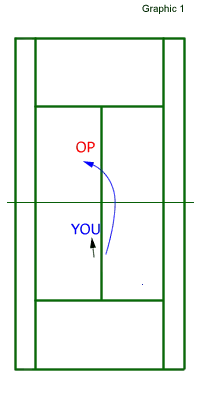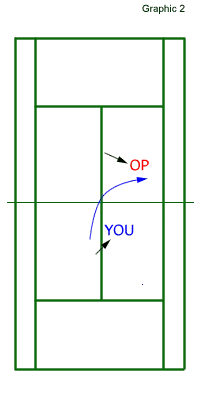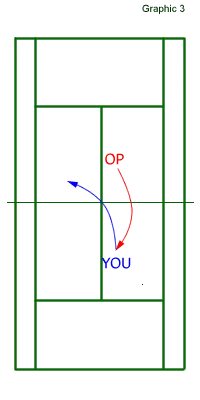Having both players at the net makes for the shortest rally in tennis due to the quick reaction and less time that players have to respond to the opponent’s actions.
To be successful in playing a net-to-net rally you must find a way to put the other player in an uncomfortable situation:
– send the ball low to him/her feet
– make him/her stretch to get to the ball
– jam him/her (hit at the body)
Covering the court when playing at the net versus the opponent up at the net involves quick reaction and a keen sense of anticipation that can be developed through a lot of matches played and paying attention to your opponent’s body language.
How to cover the court when you send the ball to your opponent’s feet (see graphic 1 below)

As soon as you notice that the opposing player is going to let the ball get low you should move closer to the net in anticipation that the next ball will be pushed up by the player.
Prepare to hit a high volley which you should intercept closer to the net. This will allow you a greater opportunity for angles and aggressive put-away shots.
How to cover the court when your opponent stretches for the ball (see graphic 2 below)

First, make sure you move in the direction of the ball (e.g. If you sent it to the right then move a step or two in that direction).
Stay behind the ball to cover the eventual down-the-line attempt from your opponent.
Second, prepare for a slow ball coming back – that’s because, most of the time, the stretched player will not have a comfortable balance to hit an aggressive volley.
Once you intercept the ball you should quickly decide to either send it to the open court (left uncovered by the stretched player) or back at the player who is trying to recover his balance.
How to cover the court when your opponent gets jammed by a ball to the body
Most of the time the reply is a weak one which you can take a little more time to attack:
– If the ball comes back high, be quick in moving forward and take it as high as you can. Do not wait for high balls to drop too low – be quick and profit from the height to create put-away and angled volleys.
– If the ball is a very short one, close to the net and you don’t have time to volley it… it is ok to let it bounce and get ready to attack it aggressively with your favorite groundstroke.
How to Play the Low Ball
This is one of the situations you don’t want to get yourself into very often – this usually happens when you stand too far away from the net.
But if you’ll have to hit a low ball I’d suggest that most of the time you should hit it cross-court!!! (see graphic 3 below)

The reasons I say hit your low volleys cross-court are:
– the net is lower for cross-court volleys which allows you to not have to pop the ball too high (your opponent will not get high volleys)
In this case, you should quickly move (in the direction of your shot) to stay behind the ball.
– the net would be higher for going down-the-line which means you will have to offer your opponent a higher volley also.
So volleying the low ball down-the-line is not a good option for you unless you have a clear opening away from your opponent.